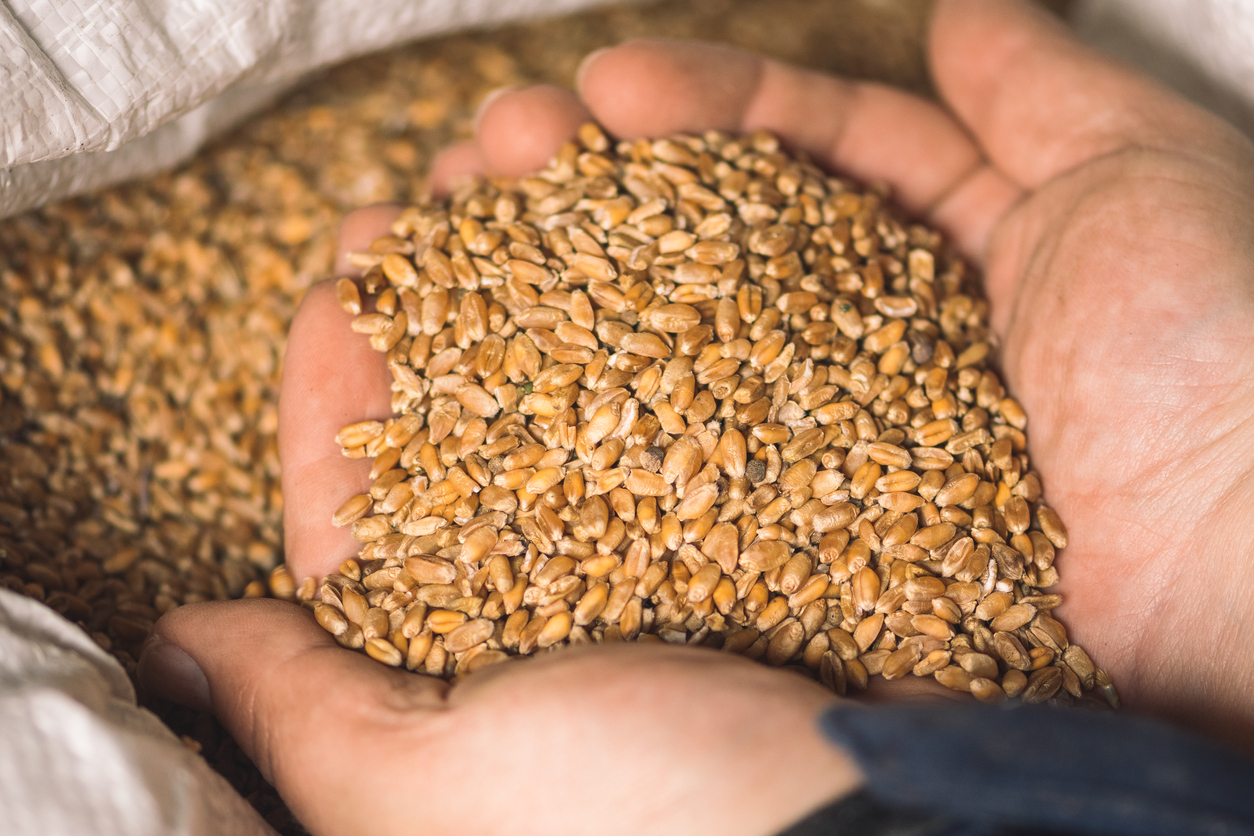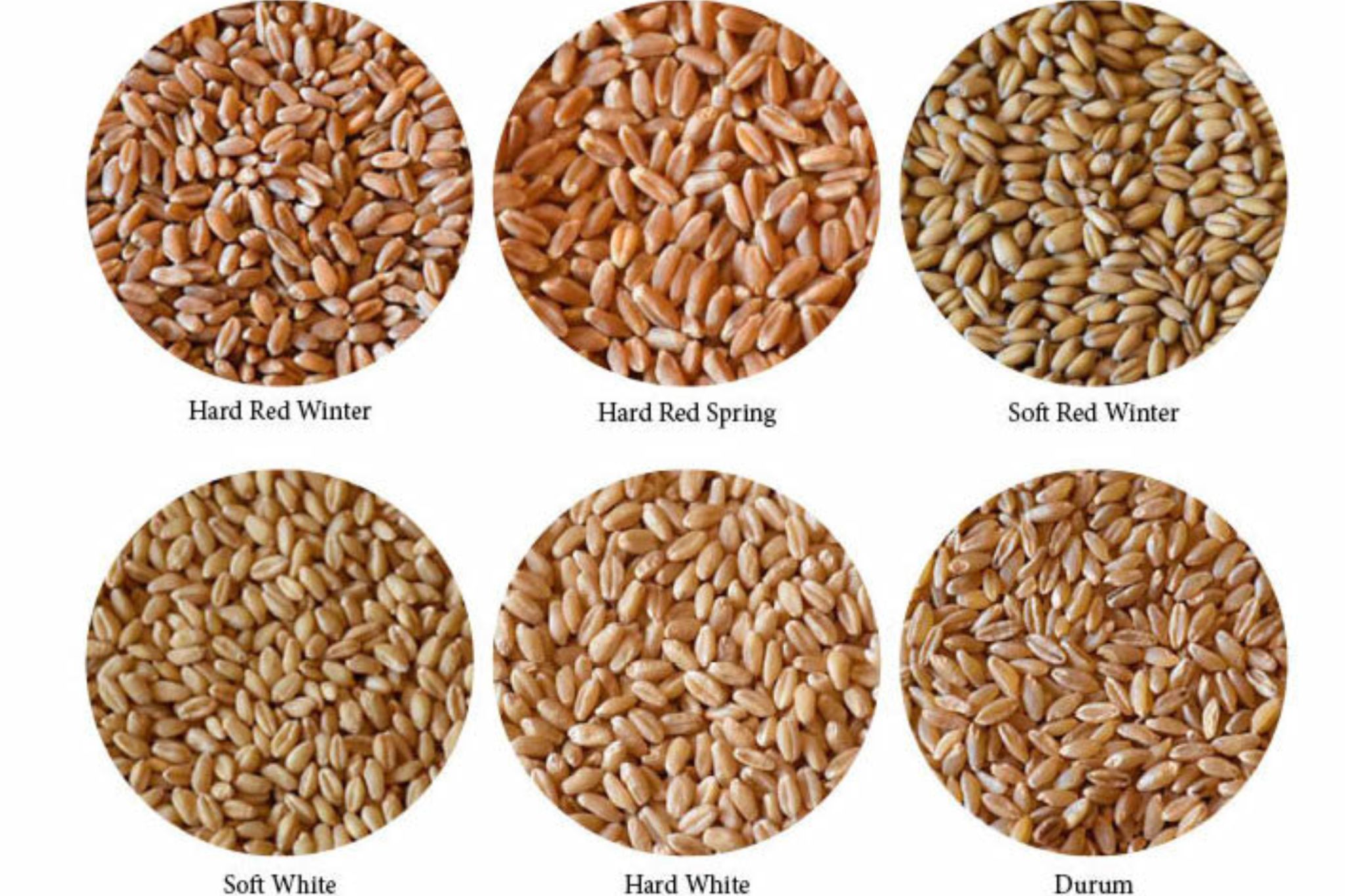For thousands of years, wheat has played a crucial role in the global food supply. Through planting and selection for desired traits, farmers in the Fertile Crescent turned wild grasses into reliable and concentrated sources of nourishment.
These days, wheat supplies a fifth of food calories and protein to the world’s population. The global production of wheat in 2023 came in at 787 million tons. That’s the weight of over 2,000 Empire State Buildings, or the amount of flour needed to make a croissant the size of Lake Tahoe (depending on the recipe, of course).
Wheat bread, in particular, has held a place of honor in the diets and cultures of many societies around the world (“Give us this our daily bread;” “Man does not live by bread alone;” or perhaps slightly less prominent, the early 1970s soft rock group Bread, who recorded the songs “Everything I Own” and “If”). But despite this long run, wheat bread’s popularity has been waning lately, thanks to advocates of gluten-free diets.
While these diets are medically necessary for people with celiac disease or non-celiac gluten sensitivity, many folks have adopted this way of eating out of fear that gluten is generally a bad thing.
Wheat is also often under attack because of the form in which it most commonly appears in our diets: the dreaded “carbs” (read: highly processed products made with refined wheat flour and a copious helping of chemicals and added sugars) that people trying to lose weight often avoid.
So what’s the deal with wheat? Is it really healthy? Or is it a primary driver of obesity, inflammation, and chronic illness that most of us, or all of us, should avoid?
What Is Wheat?

In simple terms, wheat is a grass and cereal grain cultivated for its seeds or kernels. It was probably first cultivated in the Middle East starting around 10,000 years ago.
Botanists know it as a type of fruit (but hopefully, they’re wise enough to keep it out of fruit salads). Speaking of botanists, one of them who liked Latin gave wheat the binomial Triticum aestivum, which refers to both grinding (“tritere”) and summer (“aestes”). Its other close relatives are also members of the Gramineae family (that is, the grasses).
The main protein found in wheat is that now-infamous gluten. But to be clear, wheat and gluten are not synonymous. It’s gluten that gives wheat dough its elasticity. Gluten allows air bubbles to form so that bread rises and retains its fluffy texture after baking.
Gluten is found not only in all types of wheat, but also in barley, rye, and triticale, which is a cross between wheat and rye. (I think it would have been hilarious to name that hybrid “why,” but maybe that’s just me.)
What Is Wheat Used for?
Wheat has been used as a whole grain and to make flours (including refined flours) and related products. In modern times, wheat is one of the main sources of calories for humans. Three-quarters of all US grain products come from wheat flour.
Some wheat products include the entire grain kernel, comprising the bran, germ, and endosperm. These are known as whole grain wheat products, and include unprocessed foods such as wheat berries and cracked wheat, which are the edible “fruit” of the wheat kernel in their intact form.
Lightly processed whole wheat products include couscous and bulgur, which are typically made from durum wheat, a strain of “hard” wheat.
There are also whole wheat flours and related products that are processed but have all parts of the wheat seed (bran, germ, endosperm).
Refined wheat has been milled in a process that removes the bran and germ, along with many of the nutrients (including much of the fiber, vitamins, and minerals) found in wheat. Some refined wheat flours and related products are “enriched” — meaning that a few of the lost nutrients are added back in supplemental form.
The majority of contemporary breads, crackers, cereals, cakes, cookies, and so on are made from refined wheat products.
Types of Wheat

We can divide wheat into two main categories: ancient and modern. The ancient ones are so named because they’ve been grown the same way for thousands of years, without any genetic modifications or selective breeding pressures. Compared with their modern descendants, ancient grains tend to be higher in nutrients, including fiber. They also contain more gluten, but in a form easier for humans to digest.
Diets based on ancient cultivars appear to produce less inflammation and deliver more antioxidant power than diets rich in modern classes of wheat. Some of the ancient wheat grains you might find in a local natural foods store or online include einkorn, spelt, emmer, Kamut, and farro.
Modern strains of bread wheat fall into classes that indicate what the flour is best suited for, its color, and its growing season. So you’ll find hard red winter (starring in flatbreads and croissants), hard red spring (rolls, bagels, and pizza), soft white and soft white winter (cakes and pastries), hard white (whole wheat pan breads and Asian noodles), and durum (which comes from the Latin dura, or “hard,” and is often coarsely ground and refined to make semolina flour — the favored basis for Italian pasta).
Wheat Nutrition Facts
The calories you get from wheat are mainly from carbohydrates, which include fiber. Whole wheat products are also significant sources of several other nutrients, including protein, dietary fiber, and B vitamins (especially niacin). You’ll also get a bunch of minerals, like magnesium, iron, zinc, selenium, and potassium.
The different classes of wheat have fairly similar nutritional profiles. The only big difference among wheat varieties is protein content, which can vary from as low as 8% to as high as 20% of total calories.
You will find a major difference in wheat nutrition between whole wheat products and refined ones. In the milling process that produces refined (white) flour, both the bran and the germ are removed. The outer shell or bran is mainly composed of fiber. The germ is also high in fiber while delivering a meaningful amount of protein, some healthy fats, and important vitamins and minerals. As a result, refined wheat products contain very little fiber.
As we’ve seen, many refined wheat products are also “enriched” with synthetic nutrients like B1, B2, B3, folic acid, and iron. By contrast, whole wheat products that include the bran and germ contain more micronutrients in their intact form (that is, the form that your body already recognizes and knows what to do with).
Health Benefits of Wheat

What are the health benefits of wheat? It’s a simple question, but unfortunately, we don’t have a simple answer. Most studies on the topic have asked a broader question: What are the health effects of whole grains, in general? So wheat gets lumped in with other whole grains, such as oats and brown rice, which muddies the data about wheat by itself.
On the other hand, wheat is the predominant type of grain consumed in the United States, so findings about whole grains as a food group are likely a good proxy for the health benefits of wheat in isolation.
Another issue is that most available evidence on the health effects of wheat involves a comparison of whole vs refined grain products. So whole wheat is competing, in essence, against cookies, donuts, and Wonder Bread, which might make it look a nutritional champ even if it’s not.
With all that as a cautionary preamble, let’s take a look at what science has discovered about the ways that consuming whole grains products like wheat might benefit your health.
Whole Grains and Mortality
A 2015 study that followed over 118,000 US-based health professionals for an average of 23 years, found that those who ate more whole grains had a reduced risk of dying from all causes, as well as specifically from cardiovascular disease (CVD). The study also found that replacing refined grains or red meat with whole grains daily was associated with lower CVD mortality.
A 2016 analysis of another large data set, including almost 800,000 people in the US, found a strong and consistent association between higher whole grain intake and reduced mortality, including deaths caused by CVD and cancer. The researchers endorsed dietary guidelines recommending at least three servings of whole grains per day for long-term health and longevity.
Whole Grains and Heart Disease

If whole grains can reduce mortality from heart disease, it stands to reason that they can lower the risk of heart disease as well. And that’s what several studies have discovered.
A 2008 meta-analysis of six large population studies found that consuming an average of two and a half servings of whole grains per day reduced the risk of having a heart attack or stroke by 21%. Refined grain products did not reduce this risk.
A 2022 Harvard Medical School analysis of data from the health professional health studies we already looked at (plus another 91,000 women from a separate nurses’ study) followed the subjects for an average of almost 26 years and reported that more whole grain intake was associated with lower heart disease risk. What’s interesting here is that the researchers were able to get a bit more granular about the effects of different whole grains.
Cold whole grain breakfast cereal and brown bread lowered heart disease risk, while popcorn slightly increased it (though to be fair to popcorn — we don’t know if the issue at hand was the popcorn itself, or the butter, coconut oil, salt, or chemicals that may have accompanied it). And having more than two servings of whole wheat a day didn’t seem to reduce risk any further.
Whole Grains and Diabetes
A 2013 analysis out of Norway explored data from a more global perspective, including populations from Sweden, Spain, Japan, and Germany, in addition to the US. They found that high fiber whole grains are associated with a lower risk of developing type 2 diabetes. Examples given by the researchers include brown bread and whole grain breakfast cereals.
A 2018 article summarized several meta-analyses to conclude that people who consume an average of two to three servings of whole grains per day reduce their risk of developing type 2 diabetes by 21–32% compared to people who rarely or never eat whole grains.
How do whole grains help battle diabetes? The researchers examined oodles of evidence and suggested some possible mechanisms. Whole grains can reduce major risk factors such as overweight and obesity, high blood sugar, insulin spikes after eating, and insulin resistance. The elements of whole grains suspected of providing these benefits include dietary fiber, resistant starch, antioxidants, and other important micronutrients.
Whole Grains and Cancer

A 2016 study out of Imperial College London found that whole grains were also protective against cancer. People who ate three or more servings per day were 15% less likely to develop cancer than those who avoided whole grains.
A 2020 meta-analysis also identified specific cancers whose risk may be lowered by eating whole grains. These include colorectal, colon, gastric (stomach), pancreatic, and esophageal cancers. The researchers identified a dose-response pattern: For every additional 90 grams of whole grains per day, the risk of cancer dropped by 6%. So give us this day (and every day) our daily (whole grain) bread!
I also want to point out that gluten itself can boost immune function in ways that could improve the body’s ability to fight cancer. A 2005 study out of Kagawa, Japan found that after less than a week of consuming added gluten, people’s natural killer cell (a type of white blood cell) activity increased significantly.
Whole Grains and Inflammation
Chronic inflammation is at the root of many, if not pretty much all, modern chronic diseases. A 2022 literature review concluded that eating whole grains can lower a biomarker of inflammation called C-reactive protein (CRP). This was particularly true in overweight people and those with preexisting health conditions.
One measure of inflammation is arthritis, or joint swelling. A 2023 clinical trial looked at almost 3,000 people between the ages of 45 and 79 who either had osteoarthritis of the knee or were at risk of developing it. After following those folks for an average of more than eight years, researchers found that people who ate more whole grains had a lower chance of developing severe arthritis. Specifically, dark bread and cereal with high fiber content were found to be protective.
Whole Grains and Gut Health

We’re learning more and more about the importance of the microbiome for overall health. And a rich diversity of beneficial bacteria is a big part of microbiome health. A 2023 study found that eating more whole grains — and their fiber — was associated with higher concentrations of some of the most beneficial gut critters, with names like (warning: the following words may be hard to pronounce, but could come in handy in a particularly fierce game of Scrabble) Bacteroides plebeius, Faecalibacterium prausnitzii, Blautia producta, and Erysipelotrichaceae. Consumption of refined grains, which are missing fiber, was associated with less variety of gut bacteria. And in a study published in the journal Nutrition in 2012, researchers found that the bran in whole wheat contains a critical prebiotic fiber that boosts bifidobacteria content within the gut, helping to relieve many gastrointestinal issues.
One question of great interest to some health enthusiasts is whether ancient strains of wheat are better for us than modern ones. A 2022 study explored this question by recruiting 20 healthy adult participants to eat a pasta-heavy diet for 16 weeks — 8 weeks of ancient grain pasta, and 8 weeks of modern grain pasta, with an 8-week break in between. (Actually, “pasta-heavy” is relative; they had 800 grams of dry pasta each week, which may not seem like much to a dedicated pasta lover.)
Researchers found that the overall diversity of the gut bacteria didn’t differ between ancient or modern wheat. But the pasta from the ancient grain seemed to increase the bacteria’s production of some fatty acids that are associated with better health.
Importance of Wheat
Human beings have eaten around 6,000 different plant species during our time on planet Earth, the most common and most significant sources of calories being the energy-dense cereal grains and tubers. These days, we source the vast majority of our collective calories from just nine plants. And three of them — rice, wheat, and maize (corn) — provide 50% of the total energy consumed by people.
The idea was that this kind of monocropping would produce efficiencies of scale and allow farmers to produce enough food for a rapidly growing human population. The downside is an increased fragility and higher risk to the food supply, as dependence on such a small number of key crops makes populations vulnerable to all manner of disruption. Examples include the ongoing (as of this writing) Russia-Ukraine war, climatic disturbances like prolonged droughts or catastrophic flooding, and pest damage.
That said, the reality is that wheat is one of the most widely cultivated crops in the world. And as it’s highly nutritious, it can help fight hunger alongside other cereal grains like rice and corn.
Wheat also has a part to play in helping populations transition away from meat-intensive diets. Vital wheat protein, also known as seitan (pronounced “say-tan”, not like the personification of evil), is a high-protein, plant-based meat alternative that is made up almost entirely of gluten. Its chewiness can mimic the texture of chicken or beef. And since it doesn’t contain soy, it’s beneficial for people who want to avoid meat and who are allergic to the soy commonly used in meat substitutes.
Powdered vital wheat gluten can also be used as a binding agent, helping products like mushroom or chickpea burgers hold their shape, rather than throwing themselves into the barbecue grill at the first suggestion of heat.
Seitan is still a highly processed food, so if you’re looking for maximal health benefits from wheat consumption, you’ll still want to stick to mostly whole grain wheat products.
Downsides of Wheat
Despite its importance in feeding the world, wheat does come with some significant downsides.
Wheat and Gluten Allergies

One of the biggest issues with wheat is that a significant number of people feel miserable or even become ill from consuming it.
Wheat is one of the eight most common allergens. People experience wheat allergies when proteins in the wheat bind to specific antibodies made by their immune system — basically, a false alarm that gets treated like an actual external threat. Symptoms can involve the skin, gastrointestinal tract, and respiratory system. Extreme cases can produce anaphylaxis, a potentially fatal reaction characterized by a violent overreaction of the immune system.
Some people who are reactive to wheat can eat barley, rye, or ancient forms of wheat like spelt, without experiencing the same problems.
However, a wheat allergy is not the same as a gluten allergy — which is also known as celiac disease (an autoimmune disease). In people with celiac disease, the body produces antibodies in response to gluten consumption that result in inflammation and damage to the lining of the small intestine.
Many celiac symptoms therefore involve the gastrointestinal tract. Because the disease interferes with digestion, sufferers can also experience skin rashes and disorders as a result of nutrient deficiencies.
Non-celiac gluten sensitivity (NCGS) is also a condition characterized by symptoms (both in the intestines and in other parts of the body) related to the ingestion of gluten-containing foods. NCGS occurs in the absence of celiac disease and wheat allergy.
NCGS is not well understood, which you can infer from its name (which basically describes what it isn’t rather than what it is). In some people, it may actually be an intolerance to FODMAPs, or Fermentable Oligosaccharides, Disaccharides, Monosaccharides, and Polyols. These are all different types of short-chain carbohydrates fermented by your gut bacteria — and some people poorly absorb them.
Another theory is that NCGS may come from the unnaturally high concentrations of gluten in many modern strains of wheat.
For more information on gluten and the various sensitivities, allergies, and diseases it impacts, check out our comprehensive article here.
The Hyper-Processed Problem
Unfortunately, many ultra-processed foods start with grains like wheat. The processing begins when whole grains are milled (even when the bran and germ are intact). This accelerates the speed at which your digestive tract absorbs glucose from food, which causes greater spikes in blood sugar and insulin levels after eating.
The next level of “ultra-processing” involves stripping away the outer shell and germ, turning wheat from a complex to a simple carbohydrate (that’s what gives “carbs” a bad name). Simple carbohydrates, like refined flour, cause people to consume more calories than when bundled with fiber and other nutrients, which can lead to weight gain and higher levels of body fat.
For more on flours and whether any of them are healthy, check out our full article here.
The Glyphosate Problem

Another issue with wheat is the herbicide and desiccant glyphosate, which is applied to most nonorganic wheat crops before harvest to encourage faster ripening. This results in glyphosate residues in commercial wheat products. Glyphosate likely causes cancer, DNA mutations, and birth defects, as well as disrupts the microbiomes of humans and the soils it saturates.
To reduce your exposure to glyphosate, you can buy organic wheat and wheat products.
The Livestock Feed Problem
Surprisingly, about 20% of the wheat grown worldwide ends up not in our bellies, but as feed for livestock. Cycling nutrients through animals is incredibly inefficient in terms of calories wasted: The world’s cattle alone consume enough grain and soy to feed more than 8 billion people. Growing all that grain uses up land that could grow food directly for humans.
Animal agriculture thereby drives hunger by reducing the global food supply. To truly fight hunger, yields and land use of grains need to be redirected from animal feed to human consumption.
There’s another problem with using grain to feed cattle that end up on our plates. Grains like wheat create a higher acidity level in cattle digestive tracts. This can lead to a proliferation of harmful and potentially lethal E. coli bacteria that can end up in our food supply.
Wheat Is Not the Bad Guy — for Most People

Wheat is a controversial food because of its association with processed simple carbohydrates and the protein gluten. It’s also problematic in terms of herbicide use and its role in animal agriculture. And some people are allergic to wheat, or to gluten. But for most of us, wheat still has something valuable to offer. When consumed as a whole grain, especially in intact forms, and as part of an overall healthy dietary pattern, wheat can be beneficial for the majority of people.
Tell us in the comments:
- What is the role of wheat and wheat products in your diet?
- What did you find surprising in this article?
- Will you make any adjustments to your diet based on this information?
Featured Image: iStock.com/katerinasergeevna



